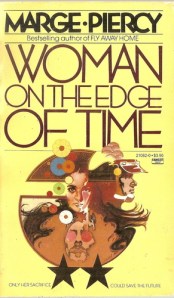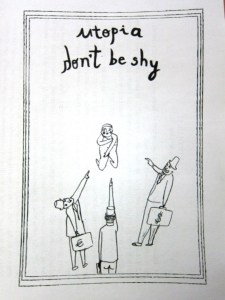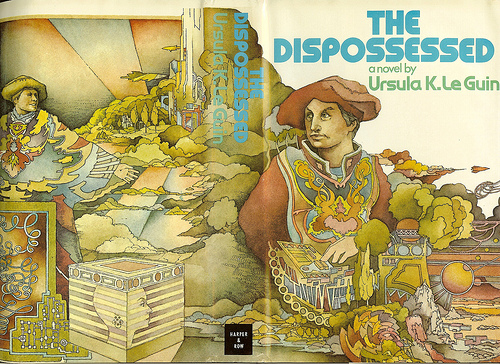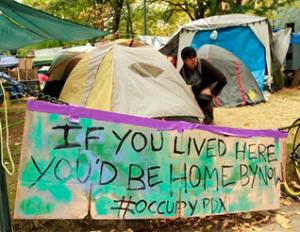(wild bells) A warm Disordered welcome to Wanda Vrasti, who previously guested on the topic of the neoliberal tourist-citizen imaginary, and now joins the collective permanently. And glad we are to have her. Her academic writings thus far include Volunteer Tourism in the Global South: Giving Back in Neoliberal Times (which came out with the Routledge Interventions series a few months ago), ‘The Strange Case of Ethnography in International Relations’ (which caused its own debate), ‘”Caring” Capitalism and the Duplicity of Critique’, and most recently ‘Universal But Not Truly “Global”: Governmentality, Economic Liberalism and the International’.
It’s often been said that this is not only a socio-economic crisis of systemic proportions, but also a crisis of the imagination. And how could this be otherwise? Decades of being told There Is No Alternative, that liberal capitalism is the only rational way of organizing society, has atrophied our ability to imagine social forms of life that defy the bottom line. Yet positive affirmations of another world do exist here and there, in neighbourhood assemblies, community organizations, art collectives and collective practices, the Occupy camps… It is only difficult to tell what exactly the notion of progress is that ties these disparate small-is-beautiful alternatives together: What type of utopias can we imagine today? And how do concrete representations or prefigurations of utopia incite transformative action?
First thing one has to notice about utopia is its paradoxical position: grave anxiety about having lost sight of utopia (see Jameson’s famous quote: “it has become easier to imagine the end of the world than the end of capitalism”) meets great scepticism about all efforts to represent utopia. The so-called “Jewish tradition of utopianism,” featuring Adorno, Bloch, and later on Jameson, for instance, welcomes utopianism as an immanent critique of the dominant order, but warns against the authoritarian tendencies inherent in concrete representations of utopia. Excessively detailed pictures of fulfilment or positive affirmations of radiance reek of “bourgeois comfort.” With one sweep, these luminaries rid utopianism of utopia, reducing it to a solipsistic exercise of wishing another world were possible without the faintest suggestion of what that world might look like.
But doing away with the positive dimension of utopia, treating utopia only as a negative impulse is to lose the specificity of utopia, namely, its distinctive affective value. The merit of concrete representations of utopia, no matter how imperfect or implausible, is to allow us to become emotionally and corporeally invested in the promise of a better future. As zones of sentience, utopias rouse the desire for another world that might seem ridiculous or illusory when set against the present, but which is indispensable for turning radical politics into something more than just a thought exercise. Even a classic like “Workers of the World Unite!” has an undeniable erotic (embodied) quality to it, which, if denied, banishes politics to the space of boredom and bureaucracy. It is one thing to tell people that another world is possible and another entirely to let them experience this, for however shortly.
Most concrete representations and prefigurations of utopia from the past half century or so have been of the anti-authoritarian sort. Whether we look at the literary utopias of the ‘70s (Ursula le Guin’s The Dispossessed (1974), Marge Piercy’s Woman on the Edge of Time (1976), Sally Miller Gaerhart’s Wanderground (1984)) or the concrete utopias of intentional communities and anti-war affinity groups from the same period, the soup kitchens and street parties of the anti-globalization movement, Argentina’s occupied factories, or the Occupy camps from last year, all of these examples bring into relief an egalitarian, bottom-up, democratic socialist vision very different from the socialist realist aesthetics that preceded it. The strong emphasis on cooperation, equality, mutual aid, liberation, ecological wisdom, feminism, and creative living informing them is traceable to the New Left counterculture, but even more so to its anarcho-communist and ecofeminist declinations present in the work of people like André Gorz, Ivan Illich, Murray Bookchin, Paolo Freire, Silvia Federici, Maria Mies, Vandana Shiva, and in a host of anti-hegemonic social movements like the Italian Autonomia, the MST, Via Campesina, the Zapatista, etc.
This intersection is not coincidental. The prefigurative bent in anti-authoritarian politics makes it ripe for utopian exploration. Unlike mass political utopias, like liberalism or socialism (whose utopian elements serve as ideological cover for various models of organization and representation), anti-authoritarian politics is not interested in seizing power or implementing a specific political program with mass support. This doesn’t mean that it shies away from engaging power, only that it is not interested in conquering or reforming it. The goal of anti-authoritarian politics is rather to relax the grip of power for people to determine their own conditions of existence in more inclusive and egalitarian ways. This rather modest concern allows anti-authoritarians to dispense with many of the distinctions and considerations typical of instrumental politics: the separation between strategy and utopia, present and future, means and ends, the ascetic postponement of the good life until “after the revolution,” or getting political representation right. Even the class antagonism found at the root of all revolutionary politics can be put aside since building a counter-hegemonic bloc is not an immediate priority.
This is no easy position to take. The courage to act as if we already lived under conditions of freedom, as if our dreams were not threatened by domination or repression, and, therefore, did not require the careful choosing of an appropriate strategy for long-term success, invites more scorn than applause. Utopia is for fools! Without a way to generalize and democratize utopia, its radical content will sooner or later become a lifestyle choice only a handful of people (activists) can embrace and enjoy. There is some truth to this indictment, but it misses entirely the function of utopian representation, which should be judged less in terms of its strategic, long-term efficacy than in terms of its equally strategic and long-term affective resonance.
Banned from “mature” politics, the task of representing utopia has generally been women’s work. As feminists distanced themselves from the ’68 macho revolutionary culture (be it party politics or guerilla tactics), they turned to the politics of everyday life. Whether in literature or in intentional communities and affinity groups, women risked the cardinal sin of politics – being unrealistic and impractical, by building utopias from the ground up around activities they were told did not have a proper place in politics: eating, cleaning, housing, care and education. If the material foundation of capitalist domination was to be found in the home, utopia would also have to start at home, from the basic activities that reproduce the body in all its difference and social relationality. Science fiction turned out to be the most comfortable home for this exercise, with most critical utopias of the 70s being written by women. (The genre is, after all, by definition, concerned with dramatizing what dress, work, food, personal relations, and social institutions might look like under different social conditions and intentional communities.)
In the most famous example, The Dispossessed (1974), Ursula Le Guin’s writes about a resource-scarce planet, Anarres, where a syndicalist economy ensures the satisfaction of basic needs with the help of highly sophisticated technology. Its inhabitants (Odonians) live modest, communal yet highly self-directed lives. They work out of passion and conviction, consume goods only for their use value and do away with luxuries. They live and take meals communally, education and health care are universal, energy is renewable and used with great care, and art, celebrations and rituals are integrated into the everyday. Le Guin borrows generously from Murray Bookchin’s radical libertarianism, Kropotkin’s principles of mutual aid, voluntarism and individual freedom, anarcho-syndicalist practices of the Industrial Workers of the World (IWW), and various elements from the civil rights movement, the ‘68 student revolts as well as socialist China, Cuba and Yugoslavia to offer an alien of a counter-image as possible to the Cold War America of her time.

An even better example is Marge Piercy’s equally famous Woman on the Edge of Time (1976), which blends together elements from peasant societies, creole and indigenous cultures, and the American counter-culture into a profoundly anti-sexist, anti-racist and anti-ageist utopia. Piercy’s strength is that, rather than basing female liberation on the elimination of domestic work, as many feminists have done, she makes female forms of action and knowledge into the formative element of her social vision. Parenting and farming are the most esteemed and valorised types of work, everything else being mechanized; everyone is involved in child rearing and is technically a “mother”; and there are dozens of festivities celebrating women’s roles. This utopia starts not with grand ambitions of liberation, equality and justice, but ends up there, nonetheless, by having the patience to first attend to the unrecognised and unrewarded work that makes life possible in the first place.
The concrete utopia of the OWS camps was, of course, never as detailed or complex. The camps did, however, take the anti-authoritarian sensibility seen in Le Guin and Piercy out into the streets, where it acquired concrete social and spatial dimensions. The camps were probably the most heavily disputed and criticized part of Occupy. Accused of breeding power differentials and exclusions, cultivating a cliquish and alienating activist aesthetics, and becoming ends-in-themselves that diverted attention from important questions of strategy and organization, they were also considered a threat to rational discourse and, not least, “health and safety.” Had these camps not existed, however, as sentience zones where people could experience first-hand the lessons of direct democracy, the joys of being together, and the advantages of a post-capitalist utopia where communication was open, work was shared, and goods were exchanged freely, the critique informing them would have remained a purely theoretical exercise without the kind of mass resonance we’ve witnessed.
The camps brought together people formerly disillusioned with (parliamentary) politics as well as people who had only known each other via social networks. They brought back the body to the public sphere of politics – not the smooth body from billboard ads or the criminalized body of the homeless, not the broken body of the worker or the isolated body of the consumer, but the collective body of unalienated cooperation and public enjoyment. Organized around activities deemed tasteless (cooking, sleeping, child care) or dangerous (assembling, celebrating) in public, the camps infused politics with a corporeal and even sensuous (non-rational) dimension shunned in modern politics, even in its anti-capitalist form. For many people this was a restorative experience. Isolated, depressed and discouraged by the ethos of personal responsibility, rediscovering the pleasure of being (effective) together offered immediate psychological relief and was perhaps the most important political lesson of the camps. Feminists have been saying this for years, that we should move the basic activities of social reproduction to the centre of anti-capitalist struggle, and put an end to the separation between the personal and the political, between political activism and the reproduction of everyday life. Turning protest into a way of living-in-common, turning the camps into self-reproducing “round-the-clock bodily presence,” was a far more effective strategy than anything one-off demos and strikes could have achieved. The camps practically became a vision of life after austerity.
The question, of course, is how to turn countercultural practices such as these into enduring counter-institutions. How exactly do concrete representations of utopia incite transformative action? Radical events, like the Occupy camps, where the normal order of things dissolves, divisions of labour and hierarchies get suspended, time moves faster, events seems more real, experiences arrive unmediated, and people live beyond their usual emotional, intellectual and sensorial limits are, by definition, impatient with time. When politics becomes sensuous there is not a lot of room for pragmatic questions of strategy and organization. Instead of waiting for some blueprint version of “revolution” or paving its way with ascetic and sacrificial struggles, radical events rush to live the future we desire now. Foolish as this may seem, it is not incorrect to say that change has never come from the “realists” (rationality is the language of liberal capitalism) or that for change to be effective it must be affective.
Radical politics cannot just offer a critique of the present, no matter how correct or convincing, but must also substantiate this critique with an affirmative experience people can relate to and have a stake in. Of course, there is always the danger for the utopian feeling to eclipse the difficult work needed to generalize and normalize utopia. But the solution is not to erase or deny the contribution of the camps. When the forces of reaction are engaged in a systemic campaign of erasing any collective memory of victories past, it is up to us to remember that other forms of living and cooperating are possible (or were possible for a brief period of time). It is not by the amount of change but by the courage to act for change that we should judge instances of concrete utopia.




Intelligent and helpful comment on the state of things.
LikeLike
Aye, I agree with Mr. Colledge; I don’t really get all the ins and outs, but Ms. Vrasti has exceedingly and most elegantly explained the important value of concrete utopias’ purpose, though I think it’s fun that the descriptor in the phrase can either refer to utopias being real examples or to the ground on which they happen (see, I’ve little grasp of these complex approaches).
Learned more about my liberal nature and thoughts for reforming capitalism that I expected in reading such perspectives reflected through different eyes. Very illuminating, placing me more in the communist camp than I realized or want to admit, I see, for desiring a democratic economy to keep capitalism stable and alive. Weird how it reconciles that way.
As valuable as the real thing is, I still feel, though, that getting utopias to scale requires reforming existing institutions, not by stimulating change via material incentives (alone), but with stimulating the minds of those with the means to influence change in corporate and governmental behavior; change the minds, change the means, policies become more holistic and responsible, placing us in a future space in which further changes feel more reasonable and feasible.
Of course, it goes without saying, if we have the time; for all we know, the galaxy we’re spinning through space in might run us into something rather earth shattering any minute or the equilibrium of the planet might not hold out long enough for the needed tech innovations to survive or thwart it. Only comfort is a sense of urgency now pervades the air, compelling us to leave these petty and distracting ideological fights and finally get to work.
Gory, the upcoming living wage proposal alone (indexed to inflation) could retire that topic and set us on the right course. Green industry expansion, too. Just have to get this covid crisis resolved and keep the pressure on year after year, thereafter.
Would be lots easier, though, to just migrate to squat and subsist in some woods, but I’d miss my books too much and the conveniences of tp and Chinese food,
In favor of the happy medium between both that and here and the paths to utopia, Kahlil Gibran wrote something rather salient I saw recently: “Pity the nation that is full of beliefs and empty of religion. Pity the nation that wears a cloth it does not weave and eats a bread it does not harvest.” Working that, simultaneously in practice and through policy, could also get us well under way.
Figure there’s yet hope.
LikeLike
Pingback: Soluciones Falsas